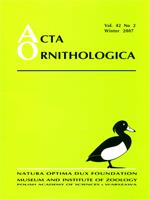The natal dispersal of a Golden Eagle from its natal eyrie to the site where it reproduced for the first time was monitored. After covering > 16 000 km2 in its three years of juvenile dispersal, and despite flying > 130 km from its natal site, the eagle finally settled in a vacant territory just 26 km away from the place where it had hatched. Almost 95% of the total dispersal area was visited for the first time during the first year of tracking; less than 40% of the dispersal area was used during the remainder of the dispersal period. During dispersal the eagle regularly visited territories occupied by adult Golden Eagles. Previous records of the occupancy of the territory the eagle currently occupies show an alternation between periods when it remained vacant with periods when subadults occupied it. Although the other member of the breeding pair is also a subadult eagle, the birds managed to raise two fledglings.
How to translate text using browser tools
1 December 2007
The First Case of Successful Breeding of a Golden Eagle Aquila chrysaetos Tracked from Birth by Satellite Telemetry
Vicente Urios,
Alvaro Soutullo,
Pascual López-López,
Luis Cadahía,
Rubén Limiñana,
Miguel Ferrer
J. Balbontín
,
V. Penteriani
,
M. Ferrer
2003. Variation in the age of mates as an early warning signal of changes in population trends? The case of Bonelli's eagle in Andalusia. Biol. Conserv. 109: 417–423. Google Scholar
C. Chatfield
2004. The analysis of time series. An introduction. 6th ed. Chapman & Hall/CRC. Boca Raton. Google Scholar
J. Clobert
,
E. Danchin
,
A. A. Dhont
,
J. Nichols
(eds).
2001. Dispersal — causes, consequences and mechanisms of dispersal at the individual, population and community level. Oxford Univ. Press, Oxford. Google Scholar
M. Ferrer
,
I. Bisson
2003. Age and territory-quality effects on fecundity in the Spanish Imperial Eagle (Aquila adalberti). Auk 120: 180–186. Google Scholar
M. Ferrer
,
V. Penteriani
2003. A process of pair formation leading to assortative mating: passive age-assortative mating by habitat heterogeneity. Anim. Behav. 66: 137–143. Google Scholar
M. Ferrer
,
V. Penteriani
,
J. Balbontín
,
M. Pandolfi
2003. The proportion of immature breeders as a reliable early warning signal of population decline: evidence from the Spanish imperial eagle in Doñana. Biol. Conserv. 114: 463–466. Google Scholar
J. R. Grant
,
M. J. McGrady
1999. Dispersal of Golden Eagles Aquila chrysaetos in Scotland. Ringing and Migration 19: 169–174. Google Scholar
P. J. Greenwood
,
P. H. Harvey
1982. The natal and breeding dispersal of birds. Ann. Rev. Ecol. Syst. 13: 1–21. Google Scholar
P. N. Hooge
,
B. Eichenlaub
1997. Animal movement extension to Arcview. Alaska Science Centre — Biological Science Office, U.S. Geological Survey. Anchorage. Google Scholar
J. Jenness
2007. Convex hulls around points (conv_ hulls_pts.avx) extension for ArcView 3.x, v. 1.23. Jenness Enterprises. Available at: http: //www.jennessent.com/arcview/convex_hulls.htm
. Google Scholar
R. Mathieu
1985. Développement du poussin d'aigle royal (Aquila chrysaetos) et détermination de l'age dans la nature par l'observation éloignée. Bièvre 7: 71–86. Google Scholar
C. L McIntyre
,
M. W. Collopy
2006. Postfledging dependence period of migratory golden eagles (Aquila chrysaetos) in Denali National Park and preserve, Alaska. Auk 123: 877–884. Google Scholar
C. L. McIntyre
,
M. W. Collopy
,
M. S. Lindberg
2006. Survival probability and mortality of migratory juvenile golden eagles from interior Alaska. J. Wildl. Manage. 70: 717– 722. Google Scholar
L. T. O'Toole
,
P. L. Kennedy
,
R. L. Knight
,
L. C. McEwen
1999. Postfledging behavior of Golden Eagles. Wilson Bull. 111: 472–477. Google Scholar
A. Soutullo
,
L. Cadahía
,
V. Urios
,
M. Ferrer
,
J. J. Negro
2007. Accuracy of lightweight satellite telemetry: a case study in Iberian Peninsula. J. Wildl. Manage. 71: 1010–1015. Google Scholar
A. Soutullo
,
V. Urios
,
M. Ferrer
2006a. How far away in an hour? — daily movements of juvenile Golden Eagles Aquila chrysaetos tracked with satellite telemetry. J. Ornithol. 147: 69–72. Google Scholar
A. Soutullo
,
V. Urios
,
M. Ferrer
,
López-López P. in press. Habitat use by juvenile golden eagles in Spain. Bird Study. Google Scholar
A. Soutullo
,
V. Urios
,
M. Ferrer
,
S. G. Peñarrubia
2006b. Dispersal of Golden Eagles Aquila chrysaetos during their first year of life. Bird Study 53: 258–264. Google Scholar
A. Soutullo
,
V. Urios
,
M. Ferrer
,
S. G. Peñarrubia
2006c. Postfledging behaviour in Golden Eagles: onset of the juvenile dispersal and progressive distancing from the nest. Ibis 148: 307–312. Google Scholar
StatSoft, Inc. 2001. STATISTICA (data analysis software system), version 6.
www.statsoft.com
. Google Scholar
D. P. Whitfield
,
A. H. Fielding
,
D. R. A. Mcleod
,
P. F. Haworth
2004. The effects of persecution on age of breeding and territory occupation in golden eagles in Scotland. Biol. Conserv. 118: 249–259. Google Scholar
<
Previous Article
|

Acta Ornithologica
Vol. 42 • No. 2
December 2007
Vol. 42 • No. 2
December 2007
breeding
juvenile dispersal
natal dispersal
raptors
satellite tracking




